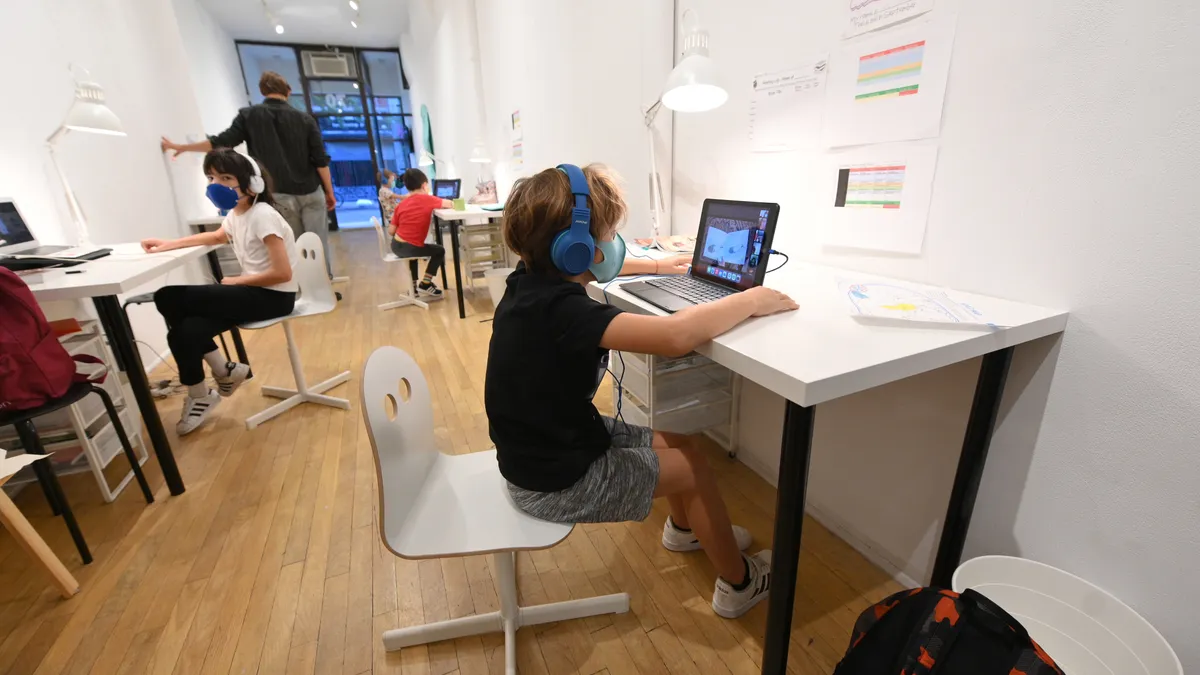Dive Brief:
- The average weekly cost of learning pods was $306 per family during the 2020-21 school year, according to a new report by the Center on Reinventing Public Education. The report surveyed 152 families and 101 instructors in 33 states who participated in learning pods at that time.
- Just 37% of parents said their children had a much better or slightly better (21%) experience in a learning pod compared to their pre-pandemic schooling, according to CRPE. Almost a fifth of families (17%) said their child’s podding experience was slightly worse, while 8% called it much worse.
- Moving forward, CRPE said learning pod arrangements are delicate and need systemic support for sustainability for parents who want to continue benefiting from this model. Policies that help provide funding or decrease regulations surrounding learning pods would help parents run these pods, said Jennifer Poon, the report’s co-author and a CRPE fellow.
Dive Insight:
Pandemic pods came about during a time of acute need for parents who could afford to pay for some form of in-person instruction for small groups of children to still interact amid school building closures because of COVID-19.
Now that most schools have returned to in-person learning, the scale of pods will decrease, but ongoing policies are looking to make space for this innovative model, said Alex Spurrier, an associate partner at Bellwether Education Partners.
“The question of if pods endure, is a question of how much from a policy perspective and a funding perspective we’re willing to reduce some of the resistance to their existence,” Poon said.
There are also several state laws that prevent regulation of learning pods similar to accountabilities in place for schools or child care providers, Spurrier said. Less regulation will help parents form and continue learning pods, he said.
“The question that remains to be seen is what policymakers can do to provide support for families that do want to have a learning pod as an option for their child,” Spurrier said.
In the last year or so, states increasingly passed policies allowing families to use Education Savings Accounts to pay for state-approved education expenses, and this could be one way to help families pay for learning pods, Spurrier said.
Another big question policymakers have to ask is about the accountability and transparency needed if they reduce legal and administrative barriers to learning pods, he said.
The National Education Association released a report in August 2020 cautioning against creation of pandemic pods, micro-schools and home education, saying these models can widen the opportunity gap for students.
There are also no certifications needed for pod instruction, the NEA report said, and even credentialed teachers don’t have guaranteed job protection or benefits in this situation.
As of spring 2021, 55% of families were interested in sustaining their learning pods beyond the school year, compared to 36% who were not and 12% who said “it depends,” the CRPE report found. However, anecdotal evidence and follow-up interviews by CRPE found most families interviewed had decided to send their children back to school.
Instructors were more interested in continuing pandemic pods beyond the 2020-21 school year, as 68% of pod instructors expressed interest in sustaining them, while 10% were not interested and 22% said “it depends,” according to the CRPE report.
CRPE also found 80% of students participating in learning pods were 8 years or younger and 80% of the pods were directly formed by the families engaging in them.
Even if learning pods don’t endure, there is a possibility K-12 schooling can learn from this model.
In fact, a Louisiana state law passed in June permits public schools to create learning pods with a minimum of 10 students as an extension of the school for small group learning.
The personalized, learner-centered model of pods that meets the individual needs of each student is something districts can incorporate already, Poon said.
This would require schools to rethink staffing structures and schedules. Districts could also rethink how teachers instruct by creating teacher teams with complementary skill sets, Poon said.








 Dive Awards
Dive Awards





